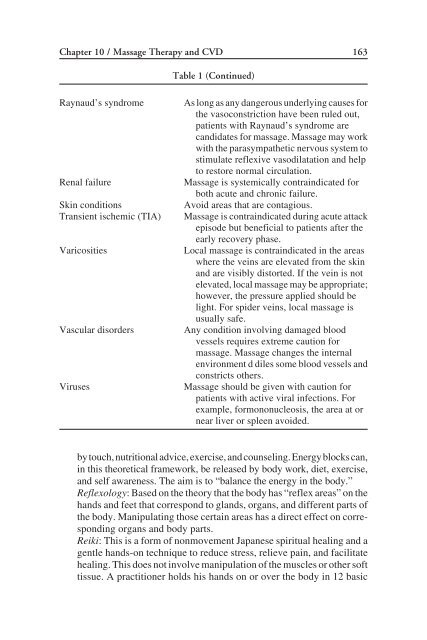Complementary Alternative Cardiovascular Medicine
Complementary Alternative Cardiovascular Medicine
Complementary Alternative Cardiovascular Medicine
You also want an ePaper? Increase the reach of your titles
YUMPU automatically turns print PDFs into web optimized ePapers that Google loves.
Chapter 10 / Massage Therapy and CVD 163<br />
Table 1 (Continued)<br />
Raynaud’s syndrome As long as any dangerous underlying causes for<br />
the vasoconstriction have been ruled out,<br />
patients with Raynaud’s syndrome are<br />
candidates for massage. Massage may work<br />
with the parasympathetic nervous system to<br />
stimulate reflexive vasodilatation and help<br />
to restore normal circulation.<br />
Renal failure Massage is systemically contraindicated for<br />
both acute and chronic failure.<br />
Skin conditions Avoid areas that are contagious.<br />
Transient ischemic (TIA) Massage is contraindicated during acute attack<br />
episode but beneficial to patients after the<br />
early recovery phase.<br />
Varicosities Local massage is contraindicated in the areas<br />
where the veins are elevated from the skin<br />
and are visibly distorted. If the vein is not<br />
elevated, local massage may be appropriate;<br />
however, the pressure applied should be<br />
light. For spider veins, local massage is<br />
usually safe.<br />
Vascular disorders Any condition involving damaged blood<br />
vessels requires extreme caution for<br />
massage. Massage changes the internal<br />
environment d diles some blood vessels and<br />
constricts others.<br />
Viruses Massage should be given with caution for<br />
patients with active viral infections. For<br />
example, formononucleosis, the area at or<br />
near liver or spleen avoided.<br />
by touch, nutritional advice, exercise, and counseling. Energy blocks can,<br />
in this theoretical framework, be released by body work, diet, exercise,<br />
and self awareness. The aim is to “balance the energy in the body.”<br />
Reflexology: Based on the theory that the body has “reflex areas” on the<br />
hands and feet that correspond to glands, organs, and different parts of<br />
the body. Manipulating those certain areas has a direct effect on corresponding<br />
organs and body parts.<br />
Reiki: This is a form of nonmovement Japanese spiritual healing and a<br />
gentle hands-on technique to reduce stress, relieve pain, and facilitate<br />
healing. This does not involve manipulation of the muscles or other soft<br />
tissue. A practitioner holds his hands on or over the body in 12 basic


